Avebury: Wiltshire's "Other" Stone Circle
by Moira Allen
When in Wiltshire, one should most certainly visit Stonehenge,
which is undoubtedly the world's most famous stone circle. But
one should also make time to visit Wiltshire's "other"
stone circle, Avebury -- which holds the distinction of being the
largest in the world.
Avebury is believed to have been constructed between
approximately 2600 and 2500 BC, though some estimates date the
Cove stones of the inner northern circle to as early as 3000 BC.
The site actually consists of several circles within circles. The
outermost ring is a massive earthwork: A grassy, 20-foot bank of
chalk a mile in circumference and 427 meters in diameter. Within
this bank lies a ditch, with four entrances (north, south, east,
and west). Within this ditch stands the first, and largest, ring
of stones, which encloses an area of nearly 28 acres. Once, this
ring consisted of 98 sarsen stones; today, only 27 remain
standing. It, in turn, encloses two smaller circles. The
northern inner ring measures 320 feet in diameter, with only four
of its original 27 stones still standing; the southern ring
measures 340 feet in diameter, and retains five of its original
29 stones.
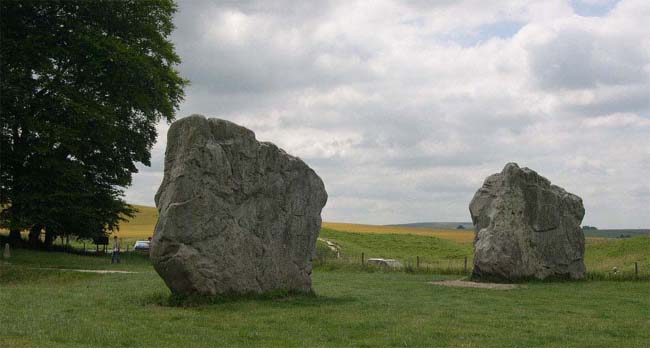
The Cove Stones
By most accounts, these two inner rings are the oldest part of
the monument, and the oldest portion of all may be the huge Cove
stones, which once stood in the center of the northern circle.
Originally there were three; today only two remain, flanking the
modern path that winds to the top of the embankment. The sarsen
stones, like those of Stonehenge, were brought from Marlborough
Downs, some two miles away -- no small achievement, given that
some weighed as much as 40 tons! The stones were then raised
into position and often set as deeply as two feet into the chalk
soil. Excavations of the surrounding ditch show that its
creation involved digging away nearly 200,000 tons of rock, using
stone tools and antler picks. There are indications that this
ditch may have originally been filled with water, so that the
stones would have appeared to have been standing upon an island
or within a moat.
The village of Avebury itself, which now stands partly within and
amongst the stone circles, did not come into existence until
nearly 3000 years after the stones themselves were erected.
There is no mention of a village at this location in the Domesday
Book, though the church and earthwork are mentioned by the name
of Aureburie. The village is mentioned as Aveberia in 1180, and
Abury in 1386; the name "Avebury" first appears in
1689, but even today, many still pronounce the name
"A'bury." This was also the name used by antiquarian
William Stukeley, who wrote about the site in 1722 in his book
titled Abury - a Temple of the British Druids.
Dr. Stukeley spent 30 years visiting, recording, measuring,
drawing and chronicling the great stones of Avebury and the
surrounding landscape. He believed that the central rings
represented a serpent within a circle, whose head and tail were
represented by two avenues of sarsen stones extending more than a
mile into the countryside. In the process, he was a sad witness
to the continued destruction of the great circle.
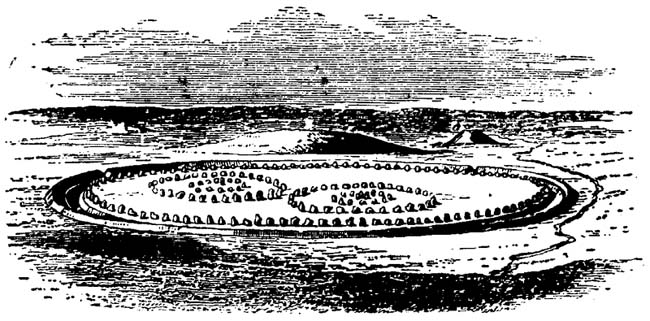
Stukeley's Proposed Layout of the Avebury
"Temple"
This destruction began in the 14th century, when local
Christians sought to eradicate such monuments to pagan worship.
During that period, many stones were toppled and buried -- though
as the host of Avebury-Web notes, this may have actually
preserved them from the far worse fate that awaited those stones
that "survived" the religious zeal of the Middle Ages.
This fate was documented in graphic detail by Stukeley, who
recorded that of the supposed 188 stones of the original
"great temple," just over 40 were still visible in his
day -- 17 standing, 27 "thrown down or reclining."
(John Aubrey recorded 73 surviving stones in 1648; by 1815,
writer Richard Colt Hoare observed only 17.)
The destruction witnessed by Stukeley had nothing to do with
religion. In the 18th century, villagers sought to clear the
stones from their fields, or to break them up for use in
building. Stukeley writes:
Just before I visited this place... the inhabitants
were fallen into the custom of demolishing the stones, chiefly
out of covetousness of the little area of ground, each stood on.
First they dug great pits in the earth, and buried them. The
expence of digging the grave, was more than 30 years purchase of
the spot they possessed, when standing. After this, they found
out the kanck of burning them, which has made most miserable
havock of this famous temple. One Tom Robinson the
Herostratus of Abury,* is particularly eminent for
this kind of execution, and he very much glories in it. The
method is, to dig a pit by the side of the stone, till it falls
down, then to burn many loads of straw under it. They draw lines
of water along it when heated, and then with smart strokes of a
great sledge hammer, its prodigious bulk is divided into many
lesser parts. But this Atto de fe** commonly costs thirty
shillings in fire and labour, sometimes twice as much. They own
too 'tis excessive hard work, for these stones are often 18 foot
long, 13 broad, and 6 thick, that their weight crushes the stones
in pieces, which they lay under them to make them lie hollow for
burning, and for this purpose they raise them with timbers of 20
foot long, and more, by the help of twenty men, but often the
timbers were rent to pieces.
Stukeley goes on to write that a single stone could provide
enough pieces to build an ordinary house, but that because of the
nature of the stone, such a house "is always moist and dewy
in winter, which proves damp and unwholsome, and rots the
furniture. The custom of thus destroying them is so late, that I
could easily trace the obit of every stone; who did it,
for what purpose, and when, and by what method, what house or
wall was built out of it, and the like."
The salvation of the circle came in the person of Alexander
Keiller, who purchased the site in the 1930's. Keiller had the
site cleared of debris and surveyed, and began the process of
excavating and re-erecting the surviving stones, or marking with
concrete plinths the locations of stones that had vanished.
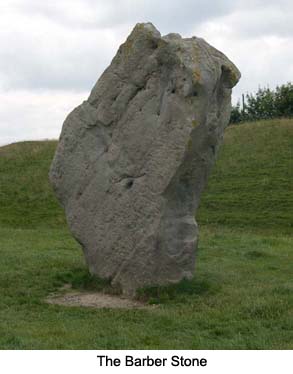 In one case, Keiller's work unearthed more than a stone!
When stone #9 of the southwest quadrant was raised, workers
discovered the skeleton of a man in the pit beneath. A leather
purse found with the body held a pair of scissors (thought to be
among the oldest ever found), a probe or lancet, a French coin,
and two 14th-century pennies from the reign of Edward I. The man
was believed to be either a tailor or a barber-surgeon; hence,
the stone has come to be known as the Barber stone. At first, it
was believed that when the stone was toppled in the 14th century,
it fell upon the man and crushed him, and he was simply left in
the grave thus created for him. More recent analysis of the
skeleton, however (which was believed lost in the Blitz but was
recently rediscovered in the Natural History Museum) suggests
that the man was already dead when placed in the pit beneath the
stone. Thus there is yet one more mystery associated with the
Avebury Circle! In one case, Keiller's work unearthed more than a stone!
When stone #9 of the southwest quadrant was raised, workers
discovered the skeleton of a man in the pit beneath. A leather
purse found with the body held a pair of scissors (thought to be
among the oldest ever found), a probe or lancet, a French coin,
and two 14th-century pennies from the reign of Edward I. The man
was believed to be either a tailor or a barber-surgeon; hence,
the stone has come to be known as the Barber stone. At first, it
was believed that when the stone was toppled in the 14th century,
it fell upon the man and crushed him, and he was simply left in
the grave thus created for him. More recent analysis of the
skeleton, however (which was believed lost in the Blitz but was
recently rediscovered in the Natural History Museum) suggests
that the man was already dead when placed in the pit beneath the
stone. Thus there is yet one more mystery associated with the
Avebury Circle! Unfortunately, Keiller's reconstruction
of the site came to a halt during World War II (when many
monuments that would be visible from the air were concealed or
camouflaged to prevent them being used as landmarks by German
planes). Since then, minor adjustments have been made to the
Cove stones, but otherwise the appearance of the henge has
remained unaltered.
More stones remain to be uncovered, however. In 1881, A.C. Smith
led a survey using probes to locate far more stones than Keiller
uncovered, and recent geophysical surveys by the National Trust
have confirmed the existence of at least 15 buried stones around
the eastern portion of the henge. This survey also revealed a
double ring of post holes in the northeast quadrant of the henge,
and another "circular feature" in the northwest
quadrant.
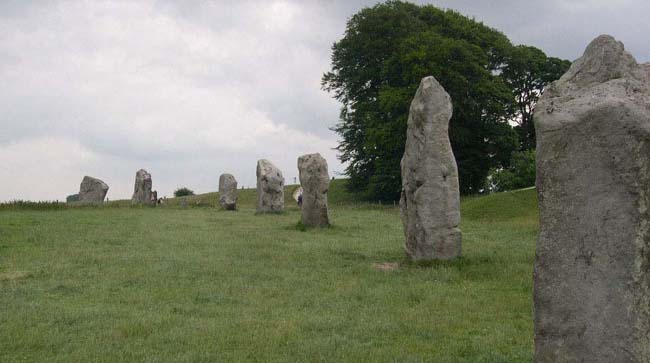
Thirty-six stones may not sound like a great many, but they are
enough to instantly strike the visitor with the sheer, awesome
grandeur of the site. What is also bound to strike any visitor
with a shred of imagination is the varied
"personalities" of the stones. Unlike some circles
where the stones are of similar sizes and shapes, the stones at
Avebury vary widely. Perhaps this is pure accident -- but when
one thinks of the effort that must have gone into hauling these
stones from their quarry two miles away, raising them upright,
and embedding them up to 24 inches in the earth, it's hard to
imagine that their appearance was utterly left to chance.
So perhaps the imaginative visitor can be forgiven for seeing in
one stone the figure of a shrouded woman, while another looks a
bit like a breaching whale. Yet another, partially split down
one side, gives the impression of a parent and child, while the
one my husband is examining rather seems to be examining him in
return!
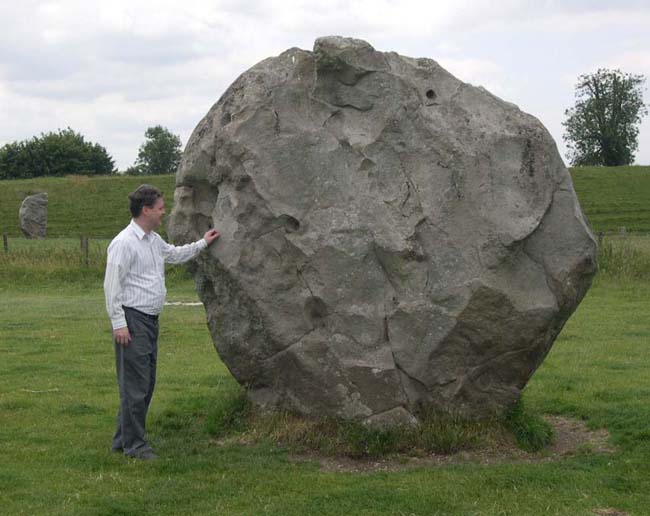
After wandering amongst the Avebury stones, the visitor can view
some of the archaeological finds from the site at the Alexander
Keiller Museum, housed in a barn on the outskirts of the village.
Here, one will also find displays describing life in Neolithic
times, and a short film about the life and work of Keiller
himself. Be warned, however: The Barn is dimly lit and unheated,
and is sometimes shut down in very cold weather.
If you're looking for something a bit warmer but still on the
spooky side, consider taking lunch or tea in the only pub in the
world to be found in the middle of a stone circle: The Red Lion
Inn. The Red Lion serves good, solid pub grub, along with a side
helping of ghost stories. One of these centers around the old
well that sits right in the middle of one of the common rooms,
glassed over so that you can actually eat on it -- if you wish!
As the story goes, a soldier who lived at the inn came home from
the Civil War in the 17th century to discover that his wife had
taken a lover. Enraged, he shot his rival and slit his wife's
throat, and pitched her body into the well, tossing in a boulder
to seal it after her. Supposedly, the lady's ghost has haunted
the place ever since. Don't let this ruin your appetite, however
-- or spoil your rest, should you wish to take advantage of the
inn's bed-and-breakfast facilities!
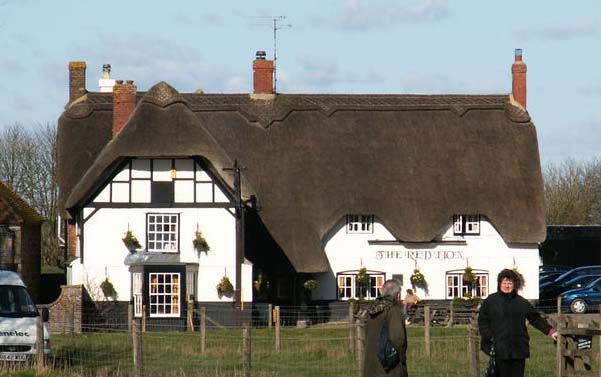
Notes: *The term "auto da fe" (or auto
de fe) means "act of faith" and refers to the
Spanish Inquisition's ritual of judging and condemning heretics.
The ceremony has generally been thought to include executions by
burning at the stake (which is no doubt what Stukeley is alluding
to), though some sources claim that the actual executions were
held separately.
**Herostratus sought to make a name for himself by setting fire
to the Temple of Artemis in Ephesus (Turkey) in 356 BC. He
boasted proudly of his act, so the authorities not only executed
him but decreed that his name should never be spoken again, on
penalty of death. Obviously it didn't work, and the name
"Herostratus" subsquently became associated with the
idea of seeking glory through acts of destruction or violence.
More Information:
We regret that we no longer have the resources to maintain up-to-date links and/or hours and pricing details for the various sites and attractions listed on this website. For more information about the location(s) listed above, please use your favorite search engine or visit Wikipedia.
Moira Allen has been writing and editing professionally for more than 30 years. She is the author of seven books and several hundred articles. She has been a lifelong Anglophile, and recently achieved her dream of living in England, spending nearly a year and a half in the history town of Hastings. Allen also hosts the Victorian history site VictorianVoices.net, a topical archive of thousands of articles from British and American Victorian periodicals. Allen currently resides in Maryland.
Article and photos © 2007 Moira Allen
|
